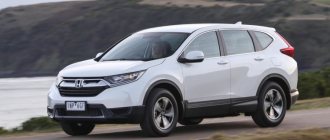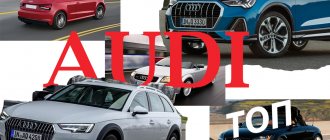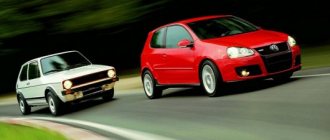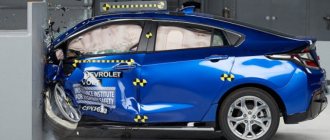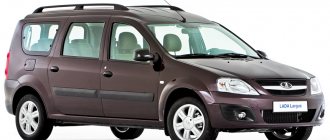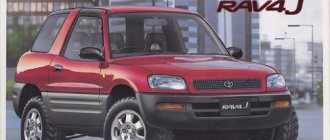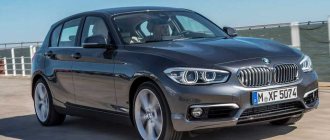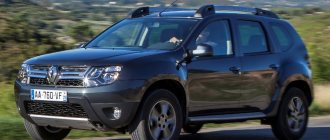Reliability rating of Chinese cars
The JD Power agency presented to the public a list of the most reliable cars produced in China and sold on the local market. The rating was formed based on surveys of more than 30 thousand buyers of local automotive products and contains a sample of 266 models of 67 car brands. In most cases, cars from world brands prevailed, however, Chinese manufacturers also showed the ever-increasing quality of their products, providing worthy competition to cars of European, American, Korean and Japanese origin.
Most of the winning Chinese models are not officially supplied to Russia. However, the situation may change, because the quality of Chinese cars is constantly improving. Consequently, the demand for products of the Chinese automobile industry, including in Russia, will increase.
Only Lada is cheaper: is it worth buying used Chinese crossovers
The main temptation is that Chinese cars in the vast majority of cases are an alternative to the domestic auto industry, which in the eyes of the average motorist is associated with a lot of technical problems. They will have to be resolved during operation. The majority, in fact, also have no illusions about the Chinese automobile industry, but there is hope: after all, this is a foreign car, even if copied. But after all, it is copied, most often, from the Japanese automobile industry - maybe I’ll be lucky and there will be more Japanese in it than Chinese.
The second part of the buyers, usually young, simply did not catch the era of the formation of the Chinese automobile industry in Russia in the early 2000s, when parts fell off on new cars rolling off a car transporter, and it took dealership mechanics two to three days to reassemble the car using improvised means and prepare it is for sale. The main thing is that for “five kopecks” there were alloy wheels, a rubber leather interior and a 2.0-liter engine, albeit of a model from the early 1980s.
Today, the Chinese auto industry has, of course, stepped forward, although not entirely and not in all respects. But on the secondary market, Chinese cars are from that very recent past. How they feel and how those who exploit them and then sell them feel. We select the most popular crossovers from the Middle Kingdom.
Chery Tiggo (T11)
Photo: Igor Zarembo / TASS
Year of manufacture: 2006-2015 Price range: 100,000 - 500,000 rubles Mileage: from 40,000 km
One of the most common Chinese crossovers on the secondary market. The car's appearance is a retouched copy of the second generation Toyota RAV4, which largely affected the sympathy for the crossover. You can often even find copies with logos re-glued.
During production, the car was equipped with four gasoline engines: 1.8 and 2.4, and later 1.6 and 2.0 liters. The motors have Japanese roots, in particular from Mitsubishi, which had a greater impact on their maintainability than reliability.
Since the first pair appeared earlier, there are more problems with them today. Generally speaking, the first step is to change all the factory fluids, if they still exist. In addition, it is worth replacing all consumables, gaskets, rubber bands, seals with imported analogues, since the quality of Chinese components left much to be desired.
Most of the attachments run 30-50 thousand km. The generator, all kinds of sensors, air flow meter, ignition coils, pumps and thermostats, as well as the timing drive, including the chain drive - it’s better to immediately replace all this with imported analogues, you still have to.
Of the gearboxes, the priority is, of course, mechanics. The Chinese bought the ancient and problematic AL4 assault rifle from the French. There are not yet enough reviews for the more modern CVT. The first all-wheel drive versions are rare, and it is better to immediately bypass them - due to a large number of problems with the clutch, cardan and gearbox, the Chery company itself quickly removed such versions from sale and did not produce them again.
Suspension elements generally last an average of 60-80 thousand km. The interior is made of cheap plastic and quickly becomes worn out. The body is not corrosion resistant - the market is full of repainted cars precisely because of rust.
Conclusion: the two main advantages of the car are a good balance of driving characteristics, consumer qualities and general maintainability. The main problem is low-quality components and poor assembly. The younger the car and the fewer Chinese spare parts it contains, the longer it will live.
Lifan X60
Photo: Lifan press service.
Year of manufacture: 2012-2017 Price range: 250,000 - 700,000 rubles Mileage: from 20,000 km
Another popular clone of the second generation Toyota RAV4, which has been thoroughly redesigned. The X60 received a massive body, a very spacious interior, a high seating position and rich equipment even in the basic version, for which it immediately became a Russian bestseller. Dealers admitted that when purchasing, people were not particularly interested in the cost of maintenance, the availability of spare parts, or warranty conditions. The price at the Logan level for a hefty “almost jeep” completely eclipsed the mind.
The car was equipped with a single engine - a converted Toyota 1.8 unit of the 1ZZ-FE series with a power of 128 horsepower, only front-wheel drive and a manual transmission. Since 2020, a poorly tuned variator has appeared.
The main technical problems are related to the frankly poor Chinese-Circassian assembly. Crooked body gaps are sometimes as thick as a finger, small and large parts falling off, low-quality components and their fastenings. The services have repeatedly recorded cases of door handles, mirrors and even pedals falling off while driving, as well as metal coming apart at welded seams. The paint on the door sills peeled off in the first month of operation on the new car and became covered with rust.
Oddly enough, the most reliable component of the car is the engine, which, with proper care and high-quality oil, runs 100-150 thousand km without any problems, after which it begins to “eat” oil. The manual transmission is mainly frustrating with transmission noise and regular bearing problems. It is difficult to predict the mileage of other parts, since any component can fail at any mileage.
The specialized forums of “Lifanovod” have long turned into design and discussion clubs, where people select control programs for electronic settings and (or) camber/toe-in alignments from Toyota, change gearboxes to Japanese ones, experiment with spare parts, re-tighten electrical wiring and in every possible way complete less important units auto. Moreover, the majority of owners, who, as a rule, switched to Lifan from a Zhiguli, consider this absolutely normal, taking any criticism about the car’s reliability with hostility.
Conclusion: if you are not a practicing mechanic-designer with a lot of free time, then buying a used Lifan before 2020 is highly not recommended. From 2020 to 2020, the X60 went through as many as two restylings: the manufacturer heeded complaints and improved both the build quality and mediocre driving characteristics. But the cost of such copies is no longer interesting - you can buy a full-fledged European competitor.
Great Wall Hover
Photo: Wikipedia
Year of manufacture: 2006-2010 Price range: 270,000 - 450,000 rubles Mileage: from 90,000 km
A full-fledged frame SUV, which is a licensed copy of the Japanese model Isuzu Axiom. The car gained popularity due to the fact that it was the only UAZ analogue comparable in capabilities and price with a much higher level of comfort.
At various times, the car was equipped with 2.0 and 2.4 gasoline engines, as well as a 2.8-liter diesel engine. The engines are also licensed copies of Mitsubishi units, so in general they last quite a long time. The base 2.0-liter engine for such an SUV turned out to be frankly weak. Expensive diesel is also rare, but owners who have it praise the engine. The main demand was for the 2.4 petrol engine.
Traditionally, for Chinese cars, the assembly was lame, in particular all kinds of fastenings. In a good way, immediately after purchase, as in the case of a UAZ, it would be a good idea to “stretch” the car and then completely replace all operating fluids. There were even poorly tightened cylinder head bolts. The timing belt drive requires increased attention and is changed already at 60 thousand km; at 70 thousand km it can break off with all the consequences.
Another problem is regular “glitches” of various sensors, especially when driving off-road. The weak point is the manual gearbox, which will require repairs with bearing replacement at 70-80 thousand km. The suspension and steering have average mileage before replacement, and the regularity of the procedure depends on the operating mode. Anti-corrosion protection of the body and painting were not of high quality.
Conclusion: probably the most reliable of all Chinese cars of its time. In fact, we have before us an almost entirely Japanese model, which was assembled not so well from not the most reliable components. In general, with caring owners, “Hovers” last quite a long time. Not for nothing, this is one of the few Chinese cars on which mileages exceeding 200,000 km are regularly found.
Generally speaking, one of the main reasons why the Chinese auto industry cannot be definitely recommended for purchase is problems with the supply of spare parts, including body parts, and service. Even for new cars, a more or less normal warranty is 1-2 years, people sometimes wait for several months for broken units, not all cars even have original data on setting the wheel alignment and other problems. And by today, the price advantage has almost disappeared.
Surely, with their persistence, Chinese automakers will correct the situation, but for now you can recommend for purchase not just any new car from the Middle Kingdom, but a used one solely at your own peril and risk.
Cherry Tiggo 3x
Cherry Tiggo 3x is the most interesting option for Russians. The fact is that the model is officially supplied to Russia, albeit under the name Cherry Tiggo 2. In the JD Power rating, Tiggo became the first in the class of small crossovers, ahead of its Chinese competitors and foreign models. Taking into account the official price of 673 thousand rubles, the car has a 5-speed manual transmission and a 1.5-liter engine with a capacity of 106 hp. With. seems like quite an interesting proposal.
Crossovers
There are, to put it mildly, few Chinese small cars in our car markets. But at the same time, among the supplied cars of this class, there are those that are worth paying attention to if you value reliability and safety.
Chery Kimo
This budget class model is distinguished by its elegant exterior. Perhaps that's why KIMO is often called "the best women's runabout."
The five-door front-wheel drive model is equipped with a small but quite efficient engine: 1.3 liters with an output of 83 hp.
The reliability of a car is a consequence not only of a good design solution, but also of good build quality, which can pleasantly surprise those who have always considered Chinese cars, to put it mildly, not up to European quality standards.
The car has good maneuverability and grips the road tightly. Good ground clearance allows you to safely drive the car on domestic roads. Fuel consumption is low even for a small car.
The disadvantages of this model include excessive suspension stiffness, a very small trunk and an overly soiled interior. But if we talk about reliability, KIMO is at its best!
Lifan Smily
This model is a worthy copy of the English Mini Cooper, so beloved in China.
Naturally, comparing the quality of Cooper and Smily is an incorrect and thankless task; the Chinese model is much inferior to the “British” one, but the cost of Smily is more than affordable.
And if we add to this the reliability of the “Chinese”, which is quite high even from the point of view of meticulous European testers, then we get a very attractive option for the city.
The designers paid special attention to the safety of their creation. Body material – high-strength steel. The engine is enclosed in an energy-absorbing cover, which, upon impact, absorbs the energy of the collision and protects passengers.
The car's brakes are equipped with a two-chamber vacuum booster, which significantly reduces the braking distance. The extended wheelbase provides good traction and can withstand significant loads.
Chery Indis
This mini-crossover is one of the most compact, equipped with a 1.3 liter petrol unit producing 83 hp. Its suspension is traditional for the class of small compact cars, allowing you to confidently overcome even rough roads.
Drivers, however, point out that at a speed of 120 km/h the car begins to have poor steering response. But a reasonable question arises: why develop such speed in a small car?
Otherwise, Chery Indis is a car that is worth the money, providing the owner with a safe ride and reliability.
Chinese drivers are very fond of sedans. Moreover, they strive to make them as long as possible.
It is noteworthy that this fashion, having been born in China, is now actively spreading beyond the borders of the Middle Kingdom. Interesting fact: when producing the Citroen C4 and Peugeot 408 models, designers used bases that were specially enlarged to suit the interests of the Chinese.
Geely Emgrand 7
This sedan looks solid enough to be popular among car owners holding responsible positions. Restyling made the appearance of the car even more solid.
The model implements all the latest security systems that have proven their effectiveness. There are two front airbags installed here, as well as an ABS system, which provides high-quality control in the event of unexpected braking, EBD, which combats car skidding by increasing the braking force of the rear axle, ESP - a dynamic motion stabilization system.
The model is made of materials that fully meet European ECE safety standards.
The result of the designers' efforts was four stars in Euro NCAP testing. The designers paid special attention to developing a body with energy-absorbing zones.
Lifan Solano II
This sedan is equipped with ABS and EBD systems. The designers also provided the model with reverse sensors and reinforced body pillars.
Disc brakes provide reliable braking and a short braking distance, and two-stage airbags effectively absorb impact energy in a frontal collision.
To be fair, it should be noted that the basic configuration of the Lifan Solano II has few security systems. But in the maximum configuration there is a very impressive list, which, in addition to the main systems, includes:
- seat belt indicators;
- parking sensors and blind spot monitoring for the driver;
- child locks for rear doors and ISOFIX fasteners for child seats.
Taken together, these systems increase driving safety and braking efficiency, which, combined with good body strength, makes this sedan one of the safest models of the Chinese automobile industry in this class.
Faw Oley
This model is equipped with a one and a half liter engine producing 102 hp. The unit does not have a fast start, but otherwise this model can satisfy quite demanding requirements.
Read more: Video card rating 2020: beautiful graphics are available to everyone
As for safety, there is a wide range of both active and passive safety features: automatic door locking when driving, front airbags, ABS, EBD systems.
It is noteworthy that even in the basic configuration the model is equipped with 5-spoke sports wheels, electric mirrors and customizable front optics.
The overall impression is somewhat spoiled by the quality of the paintwork and the difficulties that may arise with servicing the car.
Chinese manufacturers are experienced traders. They supply our market with crossovers of their own production, which cope well with the peculiarities of our roads and at the same time cost quite a budget.
Chery TIGGO 5
Tiggo 5 is notable primarily for the fact that it received five stars in the C-NCAP crash test.
The TIGGO body is indeed highly durable - up to 45 percent of the entire body is made of high-strength steel. The body has its own strength zones and is designed so that in rear and frontal collisions it perfectly absorbs collision energy.
The good news is that the designers managed to design the body in such a way that in the event of a collision it does not fold inward, preserving living space for passengers inside the cabin.
This characteristic was achieved not only due to the strength of the body, but also using laser welding - this technology connects parts at the level of molecular interaction, providing it with a third more strength than with classical welding.
Lifan X60
This model is well-deservedly popular due to its classic style, fairly powerful 1.8 liter engine and affordable price.
The car can be considered a budget car, but at the same time it is equipped with all the modern “spaces” to ensure safe and reliable operation.
Among the disadvantages of the model, we can mention not very good cross-country ability on bad roads, expensive maintenance and frequent assembly flaws.
Geely Emgrand X7
Compared to the previous mentioned crossover, the Geely Emgrand X7 is more expensive, but the combination of “quality and price” in it can perhaps be considered more optimal.
The model’s suspension quite successfully copes with all the potholes and potholes on our roads, and the safety systems, including ABS and front airbags, provide the required level of reliability and driving comfort.
The problems of the car are mainly related to closing the doors and the operation of the air conditioner, which, we agree, although unpleasant, is not critical if we are talking about the reliability of the car as a whole.
Chinese SUVs have long gained popularity among outdoor enthusiasts. Attention to detail has provided the Chinese with some success in the production of cars of this class.
Haval H9
This SUV competes quite successfully with popular jeeps in the USA and Europe.
The car is equipped with either a 245 hp gasoline engine. or a diesel unit with a capacity of 190 hp. and an eight-speed automatic transmission.
The frame structure is able to ensure a safe ride. The model also contains a lane marking monitoring system, an automatic braking system, and a parking assistant.
Great Wall Wingle 5
The model looks stylish even against the backdrop of European SUVs and pickups.
The connected all-wheel drive system allows you to save on fuel consumption, while the vehicle's payload capacity is impressive - 975 kg.
Drivers who have experience operating the Great Wall Wingle 5 note its good anti-corrosion protection and high cross-country ability.
The only negative, perhaps, is the minimalism of the SUV, but here you have to choose between price and dimensions.
Foton Sauvana
It is not for nothing that this model takes its position in the top of reliable SUVs. The frame design and excellent powerful power unit from the best automobile manufacturers provide the vehicle with reliable and durable operation.
Among the minuses, owners of Foton Sauvana note certain inconveniences when parking in large densely populated cities, but here it’s “either checkered or go”: an SUV is not exactly a car for big cities.
Conclusion
Chinese cars have quietly but surely spread throughout the world, and our country is no exception.
And if recently their distribution was hampered mainly by their low quality, coupled with difficulties in acquiring spare parts, now the growing reliability of Chinese models will most likely lead to the fact that Chinese cars will continue to confidently conquer the international market.
Externally, this brand is quite recognizable, although many people confuse it with cars from Mazda. The lighting equipment installed here is the most modern, all lines are smooth, which contributes to the streamlining of the body. This reduces air resistance when driving at high speeds and reduces the amount of fuel consumed.
The length of the car is 465 cm with a width of 181 cm and a height of 175 cm. This is an all-wheel drive model, and the rear drive cannot be disabled. The radiator grille has a unique shape. In the manufacture of the body, only high-quality metal was used, which has a significant margin of strength - this moment gives the car additional solidity.
Dongfeng Forthing Joyear X5
Forthing Joyear X5 is another winner in the small crossover class, second only to two models from Cherry. The car, which borrowed its name from BMW and its design from Renault Koleos, was able to beat out other competitors, which primarily included other local models.
From the technical side, the Forthing Joyear X5 is also quite interesting - the car is equipped with a 1.6-liter Mitsubishi engine with a power of 122 hp. pp., which is combined with a five-speed manual or CVT.
The most important machine parameters
Here is a list of the most important parameters of any machine:
- engine/chassis reliability;
- steering/braking efficiency;
- body strength;
- motor power;
- fuel consumption;
- maximum speed and acceleration time to hundreds;
- interior and cabin ergonomics;
- breakdown statistics.
Reliability of the engine and chassis
The engines of American, German or Japanese cars, which were produced in the 70–80s of the last century, were distinguished by their enormous engine life, regardless of the model or brand. They easily covered half a million kilometers without repair, even when operating in Russia. However, those days are over and the engines of modern foreign cars of budget classes can hardly overcome the 300 thousand kilometers bar. More than half of the engines break down before reaching a mileage of 200 thousand kilometers. This also applies to cars made in Russia; few of them will overcome the 300 thousand kilometers mark without major engine repairs, regardless of the brand or model. Against their background, cars from the Middle Kingdom look pretty good.
The average engine life of most Chinese cars is 300 thousand kilometers and at least two thirds of cars overcome this milestone. After all, the Chinese followed a proven path - they took the most reliable or popular engine of previous years and produced their own units based on it. Such power plants cannot boast of impressive data on fuel consumption and torque, but they retain the best qualities of their predecessors - reliability and unpretentiousness, which is one of the most important factors in Russia.
Because of this, it is not uncommon for only the badges on the radiator grill to help distinguish a Chinese car from an old European or American car.
The same situation applies to the chassis. The Chinese use the best practices of other manufacturers, which allow them to make a decent, inexpensive suspension. Naturally, the chassis of premium cars will always be better than that of a cheap Chinese car, but the suspension will fulfill its task of ensuring more or less smooth movement. Thanks to the simplification of the suspension, compared to more expensive cars, the chassis becomes more reliable, which is important in Russian conditions. And the cost of spare parts that various stores sell in Russia for Chinese car brands is noticeably lower than for European or American cars,
Steering and braking efficiency
In this parameter, Chinese cars of any brand are not much inferior to the market leaders in their price segment, which can be bought in Russia. Therefore, the inexpensive Lifan Solano will be able to compete in this parameter only with other Chinese or domestic Priora and Granta. The steering of the same Renault Sandero, Kia Rio or Nissan Almera is at least a little more effective: the cars obey the steering wheel more clearly and hold the road better. However, the differences are so small that they only appear during sudden, dangerous maneuvers. More expensive Chinese cars, the price of which in Russia starts from a million rubles, are sometimes in no way inferior to business-class cars from leading manufacturers in terms of the efficiency of steering and braking control.
WEY VV6
WEY VV6 is a rating winner in perhaps the most competitive class of mid-size crossovers. In the reliability competition, the Chinese model shared first place with the Volkswagen Tharu, which will begin to be assembled in Russia next year.
The WEY brand sells cars from the premium division of the well-known Great Wall company. VV6 is the most inexpensive car in the brand’s lineup. According to representatives of the Great Wall company, in the near future the WEY brand will be introduced to the Russian market, and over time, the brand’s cars will be assembled at a recently opened plant in the Tula region. So the high place occupied by the VV6 is good news for Russians as well - it is quite possible that the model will soon appear in domestic car showrooms.
Development of the Chinese automobile industry
It is impossible to trace the real history of the automobile industry due to the socialist system of the state economy. The local press has regularly reported on great achievements since the 1950s. Then the history of the Chinese automobile industry began. The media reported that factories even produced electric cars - a revolution at that time. They also suggested volumes - 150-200 thousand cars per year.
Today these figures cause distrust. And most of the cars from Chinese assembly lines were very similar to their banned foreign counterparts. Any achievement of the PRC in the industry caused delight, although there were many oddities on this basis - the same overhaul of a truck in 2 hours 7 minutes using 23 people. Or trailers made of bamboo with a service life of only a year...
The Chinese also copied the Soviet models Pobeda, Volga, ZiS. They were produced at three factories in Changcun, Beijing and Shanghai. But since the 1960s, relations between neighboring states have deteriorated and it was necessary to look for alternatives to the above machines. Western models turned out to be unavailable and local engineers took over the development of cars. Using the developments of Western capitalists, they developed several breakthrough models at that time, which received the names of mainly localities of the republic.
Chinese luxury car
For many decades, the Chinese automobile industry supplied the party leadership and diplomats with cars. Production volumes were quite modest - a couple of hundred thousand cars per year. The seven-digit figure was surpassed only in the 90s, when million-dollar volumes for leading brands ceased to be a curiosity. At the same time, cars became available to ordinary Chinese.
Baojun 730 and 360
Baojun 730 excelled in the class of microvans (compact MPVs). Among its competitors, noted by the jury, was only fellow conglomerate SAIC-GM-Wuling Automobile (Baojun brand) - the 360 model, which took second place. The remaining applicants were unable to show results above the market average, which was one of the criteria for being included in the rating and being awarded an award.
Both cars are not represented on the Russian market. Representatives of the single-volume class in Russia, unfortunately, have significantly lost popularity and lost their positions in recent years.
A worthy bid to win
In their new models, Chinese manufacturers pay a lot of attention to passenger safety.
Chinese expansion in the Russian automobile market continues at an accelerated pace. Producing increasingly high-quality products at prices that are affordable for Russian wallets, manufacturers from the Middle Kingdom are deservedly gaining a worthy position in the budget niche with quality and reliability worthy of the premium segment.
Changan Eado XT
Changan Eado XT is another model from the Middle Kingdom, which is a leader in its class of compact cars. A hatchback with a bright and stylish appearance, reminiscent of examples from the Italian design school, was able to get ahead of serious competitors. Among them are not only other Chinese models, but also, for example, the Hyundai Celesta (the older brother of the well-known Solaris), sold exclusively on the Chinese market.
Changan Eado XT is also not sold in Russia, although the previous generation was presented at official dealers of the company from Chongqing. Perhaps the new generation will soon return to the domestic car market.
Advantages and disadvantages of the Chinese
Chinese cars are called workhorses. The history of consumer goods, which were cheap and fell apart very quickly, is gradually fading away. The quality of cars is growing, and companies from the Middle Kingdom control most of the market. Some of them are opening assembly lines abroad. One example is the Borisov plant of the Geely brand in Belarus. The brand actively sponsors various projects in the Customs Union.
The advantages of Chinese cars are obvious. They are more accessible due to partial or complete localization of production and lower production costs. Another plus factor is that the yuan exchange rate is less subject to fluctuations, which is extremely important for consumers in times of economic troubles.
In terms of vehicle equipment, the Chinese are one step ahead. European and Asian manufacturers nervously smoke on the sidelines and lick their lips at the sight of heavenly interior elements and technical accessories. You will have to pay extra for some options, but reliable airbags, air conditioning or power steering are already available in the basic version. Extra options for money include an improved audio system, a panoramic roof or an improved gearbox.
Salon Brilliance V5
The quality of the units has also increased. In terms of their characteristics, some motor models are superior to their European and Asian counterparts. And transmissions and brake pads have increased their service life.
The Chinese have managed to improve the design characteristics of their cars. If earlier their cars were copied by foreign analogues, now it is easy to see original ergonomic cars from world design studios.
But there are also disadvantages. The initial budget price initially reduces the chances of recouping the investment. This list is complemented by low-quality materials (home-made steel smelting of the last century echoes) and serious problems in a number of safety issues. This mainly concerns imperfect anti-theft systems.
Geely GC9
Geely GC9 showed excellent results in a study by the JD Power agency. In the midsize car class, the GC9 beat out everyone including the Buick Verano, Kia K4 Cachet and MINI. GC9 is the most expensive and representative car in the lineup of one of the leading automakers in China. The GC9 was designed based on the development and experience of Volvo (the Swedish automaker has long been owned by Geely). Perhaps this is precisely what justifies the reliability and high quality of the GC9 model.
Latest statistics
In April 2020, Chinese automakers sold 1,545 passenger cars in the Russian Federation. Due to the COVID-19 pandemic, this figure was 36% lower compared to the same period last year.
As expected, the leader is the reputable Haval brand, which managed to sell 573 units of equipment. This is even 9% more than a year earlier. The Russians also bought 397 cars from Geely. This brand dropped by 46% compared to April 2020. The TOP 3 is closed by the Changan brand – 129 cars. The growth was 115%. What Chinese cars should you pay attention to in the near future?
London studio creates unique wallpaper by hand-painting texture samples (photos)
Convenience for the little ones: how to make a table for a meal in the country
There are smiles in the photo, sadness in the soul: what is hidden behind the beautiful photos of the blogger
Geely Vision
Vision is another Geely model that is in the top 3 in its class. The front-wheel drive sedan took third place in the compact car competition, losing to the Changan Eado XT and Hyundai Celesta. Considering the high competition in this class, the result is excellent. The previous generation of the model was officially supplied to Russia under the name MK, but in 2020 Geely stopped importing the model. Taking into account the high place occupied by the new generation, Vision’s return to the Russian market is possible.
So, we see that high-quality and reliable cars can be produced not only by luxury brands, but also by their colleagues from the Middle Kingdom.
- Author: Exudha
Rate this article:
- 5
- 4
- 3
- 2
- 1
(66 votes, average: 2.6 out of 5)
Share with your friends!
Chinese auto industry today
China's automotive industry is developing rapidly today. It is divided into two large categories. The first is the original Chinese brands - Dongfeng, Lifan and the like. Gradually, unpronounceable and Latin-pronounced Chinese names are becoming a thing of the past, giving way to English names like Brilliance. The original Chinese are constantly improving in build quality and comfort.
The second group is foreign manufacturers who have established production in the country. There are two options here - an attempt to reduce prices through cheap labor, which is gradually disappearing along with the aging of the country's population, and producing cars for the Chinese domestic market or the Asian region as a whole. Logistically, the Celestial Empire is located very advantageously, providing unlimited speed capabilities to customers.
Car brand Qoros
Geely FY11
The FY11 compact crossover coupe turned out to be very successful. It is head and shoulders above the previous generation Emgrand and looks more stylish than the respected Coolray. The FY11 is based on the platform of the sister Volvo XC40. It has a similar power plant and component equipment. The design is not for everybody, but it's quite good.
During a family dinner, a woman announced her decision to divorce
Thailand opens its borders from July 1, but tourists must follow rules
Retro photographs of couples in love who have been happily married for many years
Cars of this format are not very popular in Russia due to their high cost. But there is interest in them, judging by the sales of classmates Toyota C-HR, Haval F7x, Eclipse Cross, Renault Arkana. Success will be determined by pricing policy.
